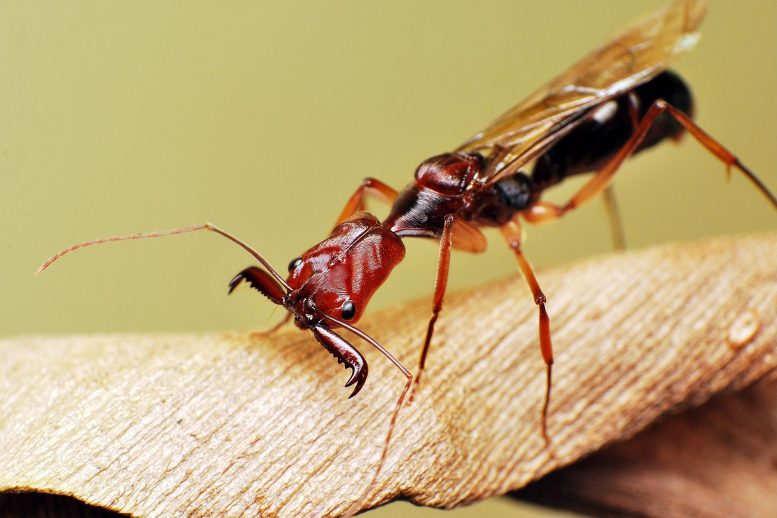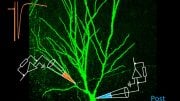The trap-jaw ants are famous for having one of the natural world’s fastest movements, but how did the latch-spring mechanism that drives their jaws evolve? According to a study published on March 2nd, 2021 in the open-access journal PLOS Biology by Douglas Booher of UCLA, Evan Economo of the Okinawa Institute of Science and Technology Graduate University, and colleagues, the core mechanism itself arose multiple times before going on to a spectacular diversification of mandible shape.
The ants need their fast jaws to catch their similarly fast prey, springtails, which themselves have a spring-loaded escape mechanism. The new findings may explain why the mechanism has evolved so many times independently around the world, eventually developing into the animal kingdom’s fastest-accelerating resettable part.
Evolutionary change is marked by occasional breakthroughs in the design of organisms, often involving the reorganization of parts into new functional systems. But understanding how transitions in function evolve when they require changes in multiple interacting parts remains a major challenge. While most agree the evolution of new complex features involves sequences of gradual changes, these transitional pathways are not yet well understood. In the new study, the researchers examined the evolution of an iconic biomechanical adaptation, the latch-spring mechanism of trap-jaw ants, to address general questions about the nature and repeatability of biomechanical innovations.
High-speed videography captures motion at a rate of 480,000 frames per second (fps) and plays it back at 30fps (16,000x slow motion). The trap-jaw accelerates faster and reaches higher speeds than the simpler gripping mechanism.
The researchers reconstructed the evolutionary relationships among 470 species of Strumigenys miniature trap-jaw ants, and surveyed mandible mechanisms using physical examination, X-ray microtomography, 3D modeling, and high-speed videography. The researchers recorded the fastest acceleration of a resettable animal movement. In addition, the findings suggest that the trap-jaw mechanism evolved independently 7-10 times in a single ant genus, resulting in the repeated evolution of diverse forms on different continents.
Most diversification of shape (from short triangular jaws to long slender ones) occurred after the evolution of latch-spring mechanisms, which can evolve through only very minor realignments of mouthpart structures. The finding that incremental changes in form lead to a change of function, followed by large morphological reorganization around that new function, provides a model for understanding the evolution of complex biomechanical traits, as well as insights into why such innovations often happen repeatedly.
Read Powerful, Deadly, Ultrafast Bite of a Trap-Jaw Ant for more on this research.
Reference: “Functional innovation promotes diversification of form in the evolution of an ultrafast trap-jaw mechanism in ants” by Douglas B. Booher, Joshua C. Gibson, Cong Liu, John T. Longino, Brian L. Fisher, Milan Janda, Nitish Narula, Evropi Toulkeridou, Alexander S. Mikheyev, Andrew V. Suarez and Evan P. Economo, 2 March 2021, PLOS Biology.
DOI: 10.1371/journal.pbio.3001031
Funding: This work was supported by subsidy funding to the Okinawa Institute of Science and Technology Graduate University (OIST) and a JSPS Kakenhi Grant-in-Aid to E.P.E. (No. 17K15180), the National Science Foundation (NSF IOS-1755336 to A.V.S, NSF GRFP 201316846 to D.B.B., NSF Postdoc 000733206 to D.B.B., NSF-DEB-16755076 to B.L.F., NSF-DEB-1932405 to J.T.L.), CONACYT (DICB-2016 #282471 to M.J.), Czech Science Foundation (# P505/12/2467 to M.J.), and a Tinker grant to J.C.G. at UIUC’s center for Latin American and Caribbean Studies. The funders had no role in study design, data collection and analysis, decision to publish, or preparation of the manuscript.










Amazing that you can study the master engineer’s handiwork and mimic the master coder and artist but not recognize what you are looking at. My friends, the world is made by an extraterrestrial. He left his calling cards everywhere so we could know that we are not alone in the universe. You are NOT looking at evolution. You are looking at the work of a being whose intelligence eclipses the combined abilities of all mankind. I think its kind of insulting to not give this being some credit for his work.